Aquaponics is a food producing system that is built on a symbiotic relationship between fish and plants.
The plants will filter the water naturally and this will create a clean environment for the fish to grow and thrive. At the same time, the fish will produce waste that will organically fertilize the plants.
The result of this symbiotic relationship are large, prolific plants and fish that can be harvested and eaten. Fish like tilapia, trout and catfish can all be grown in an aquaponics system.
The carcasses of these fish can even be used in the soil based garden so that your system creates virtually zero waste. This is why the aquaponics system holds such appeal to the homesteader.
Related: 50 Homesteading Hacks You Should Know
We are going to build a DIY aquaponics system using a simple hydroponics setup as the base.
This system will produce food outside in the sunlight or you can bring the whole system indoors, under grow lights, to produce food all year long.
Quick Setup Aquaponics Tip
When you are setting up your aquaponics system, the germination of seeds and the development of seedlings will have you waiting weeks to get your system up and running.
You can bypass this long wait using a simple trick. Soil potted seedlings, like those at your local hardware or garden center, can be easily transferred from their pots to your new system.
Materials
- Plant Hydroponics PVC System (includes cups, water pump, seed starters)
- Large Basin
- Clay Pebbles
- Seeds
- PH Test
- Plant Nutrient
- Fish Food
Assembling the PVC System
1. Whether you decide to buy one or cut your own PVC you will need to assemble the hydroponics portion first.
Related: 36 PVC DIY Projects for Your Homestead
2. If you are assembling your system from scratch do not forget to drill 2” inch holes evenly spaced the length of your growing pipe. These holes will house your growing cups.
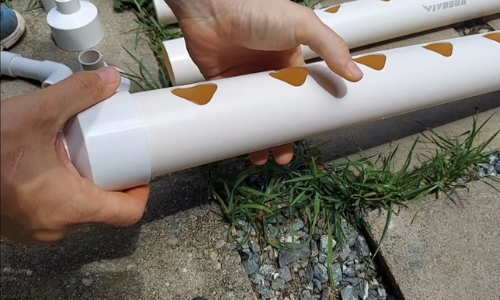
3. Connect all of your growing pipes before adding a reducer for your pump hose. This should go on one end of the connected pipes.
4. On the other end you should connect your outflow pipe.
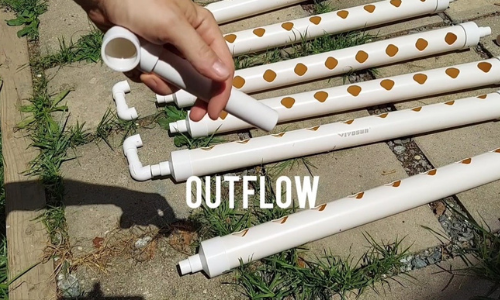
5. Your PVC frame can be built next to hold your system in place.
6. Using your basin or a small 5 gallon bucket you can test inflow and outflow of your system.
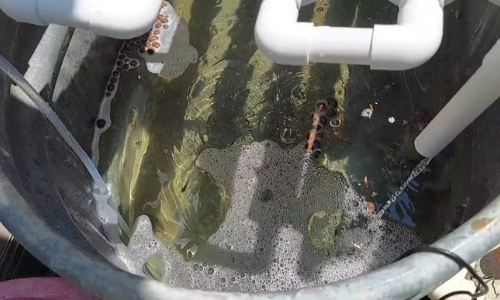
Starting Seeds
1. Seed starters like rock wool or even foam are great ways to get seeds started. Start by placing a seed or two at the center of each.
2. Place these in an area that can hold a shallow bit of water and allow the seeds to sprout.
3. Place the sprouts outside or under a grow light.
4. Meanwhile open your clay pebbles and soak them in a 5 gallon bucket. Shake them around a bit and then drain them. These will protect the roots of the plants in your system.
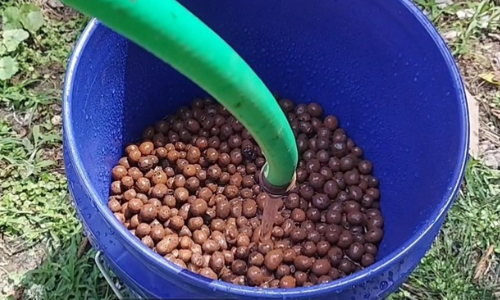
5. Once they become seedlings they can be transferred to your system.
6. Read the directions on your growing nutrient and make sure you have enough nutrient in your water to support the seedlings or plants that you are adding to the system.
Related: 13 Genius Seedling Hacks That You’ll Be Glad to Know
7. Seedlings potted in dirt can have their roots rinsed clean and transplanted into a hydroponics system. They cannot go back into the dirt after this, but they can go from dirt to water without issue.
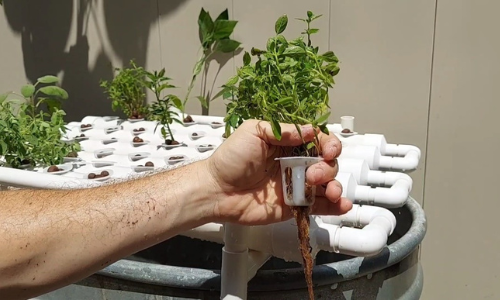
8. Test the PH of your water, and adjust if necessary, using a PH Test kit and then add your plants.
Adding Fish
1. Fill your basin with water. If it is from the hose you will have to treat it for the chlorine. This is toxic to your fish and will kill them almost instantly. Water from rain barrels is much better.
2. Water from the hose will be cold and your fish can also die from shock if you do not allow them to acclimate to the temperature.
3. You can sit the bag in the basin water to allow the fish to get comfortable and acclimated in the new temperature.
4. Finally release them into the water. Some may die and that is ok.
5. We started our system with some minnows and goldfish to keep it cheap and easy. I suggest you do the same so if you have loss, you aren’t out $100 or more for fingerling trout.
6. Feed the fish daily and keep an eye on PH for your plants and your fish.
This system will require you to keep and eye on it but little more than a daily check in is required and the annual cleaning out of the whole system.
Owning an aquaponics system does require an initial investment, but it can be a very rewarding experience. There is nothing like the feeling of sitting down to a meal made completely from plants and fish grown and harvested from one’s very own aquaponics system.
Find more on the aquaponics system and over 70 ingenious projects in the No Grid Survival Projects book. Click here to get your copy!
You may also like:
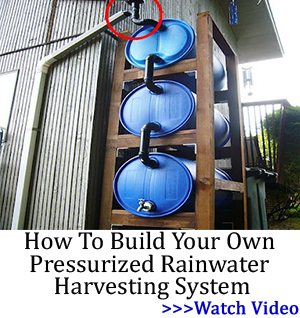 The Best Natural Treatments for Poison Ivy and Poison Oak Rash
The Best Natural Treatments for Poison Ivy and Poison Oak Rash
An Insanely Effective Way to Build a 5 Year Food Stockpile (Video)
Be Aware Of This When You Smoke Your Meat!
Ingenious Traps You Can Set Up On Your Property To Catch Looters

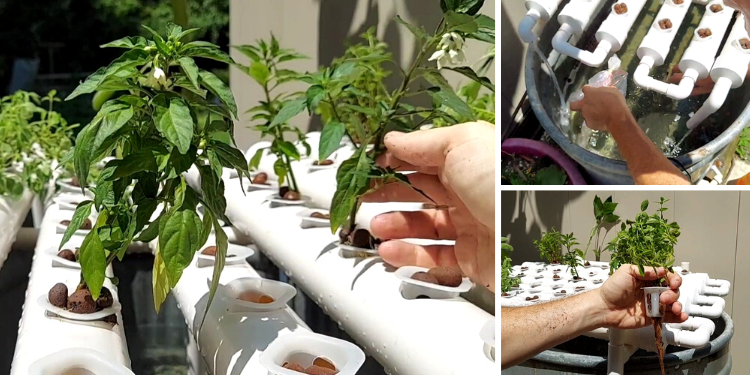




















Seems like it’s missing a lot of instructions.
Would like to see a more detailed view of it and better how to.
Good post but would like more
Is the Plastic in the PVC okay?
I am wondering about this as well. Wondering if using steel pipes would be healthier?
Plastic works. PVC is supposed to be neutral. Steel rusts out and you have to replace it. Plastic will eventually crack from exposure t the sun. niio
There are different grades of PVC pipe, just make sure you get the one that is rated for potable water. You don’t want the pipes that are rated just for waste-water.
All this is good to read, but, when having less than 5 square feet to deal with it becomes useless
Five square feet is an extremely small area, but you can build a vertical system and increase your grow area. A little research on the vertical system may lead you into some very creative ideas and designs. Instead of complaining that the article does not suit your needs, why not show some curiosity and figure out if there ARE possible options for you.
Red: yes we found us this little desert acre back in 1997 and got the heck out of the city a long time ago. Good thing too. Can’t imagine living in Tucson anymore especially these days.
Tomatoes, peppers, pole beans, bush squash. Cabbage and lettuce. This is a way to experiment with the system to learn, and only then to expand. niio
Red have you planted your pigeon peas yet? I’ve tried three times now with no luck yet. Haven’t figured out what I’m doing wrong.
Mike: No, but ASAP. Pigeon peas are tropical and I may way till near the end of the month. They like very warm soil. the cow peas were plants two weeks ago and only now are some coming up. While it’s in the upper 80s each day, nights are still lower 50s and upper 40s. Both do best in the heat and don’t need a ton of water until they bloom.
Start some in the house in good soil and see about them.
Right now it’s invasion of the packrats. A lot of stuff planted in the house is wrecked by them. so far, more than a dozen are now fertilizer, but some neighbors (they go back to Montana till winter–when the snow is deeper than their hubcaps LOL) have morning glory vines growing wild. Packrats can live on the roots and leaves. Right now, I’m fitting in peanuts, TN reds. They’re the best producers yet for my area in Arizona. niio
red- been in the 90’s down here in Vail so I figured it would be warm enough for the pigeon peas. But nights are mid 50’s or so. The Yukon gold’s and corn are coming along nicely sofar. Hilled the Yukons once already. Also some lettuce is doing well in a 5 gallon bucket. Planted tobacco from Native Seeds in Tucson and it’s really growing now.
Yes tis the season for the packrats now. A couple hungry rattlers would help. Lol.
Mike: If it ain’t got horn, thorns, ‘r fangs, it’s poison. That’s Arizona. We do a lot of hidden garden, food that looks like it’s ornamental.
Tobacco is wivian, a wild variety native here. It’s used as an herbal to stop bleeding and sterilizer wounds. http://naturalmedicinalherbs.net/herbs/n/nicotiana-rustica=wild-tobacco.php
Smoke at your own risk and always be seated when doing that. Man, that stuff is strong. Here, it’s perennial. I tried to grow domesticated tobaccos, but rodents mow it off. Birds and ants like the seeds, so it’s not too weedy. https://arizonadailyindependent.com/2015/04/19/desert-tobacco-a-pretty-but-poisonous-desert-plant/
I’m in San Pedro Canyon, north of Tucson, AKA the wind tunnel. And, I hope, all 100-150 peanut plants thrive. Some were already in bloom, and they had to go anyplace there was room. There are still 20 or so plants, but i’ll see if neighbors want them. Peanuts are survival food If an army comes by and burns off the fields. Like potatoes, raiders do not like to dig up plants, so they stay underground.
What I could do is put in some turnips about them, because they could be out in less than 60 days, where peanuts take 120. Other beds with peanuts are also growing corn and beans (cowpeas). Canna achira (the commercial starch root type) lily needs to be lifted and divided, as well. Here, they’re a perennial. Come winter, the roots should be good and starchy. All summer, seeds can be taken as a grain.
Wild sunflowers are up and while people will swipe flowers, they tend to grow like a many-armed bush. But, harvester ants stole the seeds from a bed out front, and so no sunflowers till I transplant some. Kohlrabi that was cut is sprouting, again. It’s summer, and I like that 🙂 niio
Red, the tobacco I got from Native Seeds is called Punche Mexicano, from northern New Mexico. Says it’s used for smoking. Can it be used for medicinal purposes also? Wasn’t planning on smoking it, maybe I should get some like you have. I was also just curious to see if I could grow it. Could be used for barter also if things go downhill.
Think I’ll get some cowpeas ordered this weekend from Baker’s. I like everything I’ve read about growing them.
Mike: No Healer that is a Healer would be without tobacco. It’s a hot herb, and stings. they found a grave near the Artic circle, a Healer who had a pouch of tobacco seeds. No tobacco is native to alaska, and the grave was supposed to be about 10,000 years old. It is a VALUBLE part of your meds. Hitler claimed tobacco causes cancer and told researchers to prove it. Now, all nazis agree, like Penn State.
Raise calendula for the petals. It’s better for kids because it’s gentle, but strong. War Between the States, doctors begged housewives to plant a patch in their gardens. Even battlefield wounds would be packs with the petals and prevent infections. If you’re in AZ, then protect it thru summer. In winter, Zone 9, me, it’s perennial and self-sows. niio
Red: thanks for the two links on wild tobacco. It’s growing all over our property here. Didn’t realize what it was until I checked out the links you sent. Some are going to seed now. We are about 15 or 20 miles S.E of Tucson. Will look into growing some calendula also.
Mike: OMG! You live near Tucson and I talk to you? 🙂 Ya, you earned my sympathy. When looking at homes in AZ, a realtor offered a great place in my price, 2 acres of fruit trees and a big chicken yard. The she said Pima Country and I said NO! I was escaping from one nazi state and not about to live under liberals, again. It’s not the people, but the elitist communists that own the county.
Anyway, got to stop talking about liberals. I just ate LOL. You have Punch and Hopi? Good strong tobaccos and I would plant them when the rains start. You should also try Red Flowering/Cardinal Lobelia. It needs a lot of moisture, but has no equal for quitting smoking. Gradually replace tobacco with it. On nicotine, you do not have to inhale to get the bennies and lobelia can replace it in smoked herbals like cloves and so on. Plant calèndula in the rains, along with tobacco and lobelia. Baker’s Creek carries a very resinous calèndula. Let it go to seed till next spring, then harvest petals (I take the whole flower head). Plant lavender if you have room. Flower heads when smoked are very calming but do not get one stoned. One lavender will supply a whole lot of blooms. niio
Great article, but I would like too see how the fish “tank” is connected and how you built it.
It’s usually under the unit and water is pumped up to flow via gravity back down to the fish. Gravel beds are a lot better. niio
Until you can get your system ‘balanced’ there is a lot of work tending to the ‘little things’. It’s kind of like getting a saltwater aquarium set up. The environment of the system must be balanced.
How do you deal with the algae? I bought a tiered hydroponic system from Amazon. We got the plants sprouted and in their cups. I get the nutrient level filtering through the pump that ran continuously along with the ph levels. I had it outside by the house. It grew some lettuce and a radish but after a couple weeks I started to noticee that the tube leading from the pump to the system was turning green. Even though I would change the water out every week or two. Then the cups were turning green and plants didn’t grow, soon everything was green with algae even when I cleaned it with peroxide and scrubbed it with a hose cleaner. This year I thought I’d try so.ethinh different than how they said by not hooking a pump upbut still watering and making sure they’re soaked. Anybody have any thoughts or suggestions about what I did wrong or what I should do????? It’d be appreciated, thank you!
Angela
The reason why your system grew so much Algee is because it was out side. You contaminated it with the suns rays and atmospheric debris.
You need to enclose it in a building for best results. or have it Very well established in order for it to be out side.
Good luck…
I had to block all openings so the alge didn’t get any light. Aluminum foil went around the base of each plant, as well. It’s a major help! But, if using gravel beds, you can add fishworms which eat the slime and add fertilizer to the bed. That, I think, will be the next project. Right now, the end of the hose on the unit broke, so I’m only doing Kraky method.
https://www.kratkygro.com/
niio
For my freshwater fish tanks I’ve always added freshwater snails…they yum up the algae like you wouldn’t believe.
David and feed some of the fish 🙂 niio
I dont get a ton of algae in the tank though I have considered some of those algae eater fish in the basin at the bottom. We cleaned up the pipes at the end of the year and prepared them for another year.
That cleaning at the end of the year or between harvests is going to help a lot with that.
I have done a larger system with 240 sq ft growing and 3000 gal fish tank. There is quite a bit to learn to do it right. A small system is a less expensive learning aid as described here. Do a web search for aquaponics and youtube. After you have seen three or four, you should be able to figure out how you want to start. Do you want flood and drain or continuous circulation? How do you get the needed bacteria started? pH and nutrients solutions at the right levels. You can probably learn to run a system, but it will take some learning and effort.
It is worth it! Go ahead and enjoy!
Aside from the vague instructions there was one glaring error that I noticed. Don’t bother starting plants till you have had your fish introduced into the system and the whole system running for at least a week. This allows time for the beneficial bacteria to establish themselves on your grow media. Otherwise your plants are trying to find nutrients that simply do not exist in plain water.
https://www.kratkygro.com/ is what I’m doing now. The end broke on the hose from the pump, so that’s out for now. I lost a nice crop of green beans, as well.
Always start seeds in soil. Peat is good. When the roots are getting strong, then wash off the dirt and plat in net pots.
One thing that works no matter what method, always allow some of the best plants to go to seed and use the seed in the next planting. It’s like rice. Rice needs water to grow, a lot of it, but in the wild, it’s ancestor grows on riverbands and along lake shores. Not in the water, itself. It can handle flooding and so on, but even when the rover shrinks it lives. That’s how you develop aquaponic seed. niio
I’d like to try aquaponics but don’t have the time, somehow. One video on it I watched awhile back said their 1st mistake was using a galvanized steel cattle tank, as the surface of the steel oxidized in water it released enough zinc to burn their tomato plannts, so they said to use all pvc. Instead of pumping water up to their plant cups they had them set in the pond and growing outdoors. I bet people have done some great stuff with this idea.
I’m trying this because the end of the hose to the aquaponics unit broke. https://www.growkratky.com/kratky-method-the-easy-way-to-grow-your-own-food-at-home/
Right now only 1 20 gallon tub, but we’ll see how that goes. Beans that did will in the popes did not care for the Kratsky unit, but then, we’ve been getting wind storms, as well. That might have caused the loss. niio
I have a question, can Brim or Perch be used in the Aquaponics?
Yes, you can use any hearty fish. Just Becareful so you don’t mix the wrong ones togeather.
I heard of trout and salmon used in cooler climates. Catfish, as well, if you have hot summers. Perch like warm water as do sunfish.
https://aquaponics.info/fish/perch/
Asians, who have done aquaponic for centuries like carp because they survive easily, are generally disease resistant, and omnivorous. They grow fast and are called water pigs because of it. I like them better than tilapia or ‘cats because they taste better smoked and are easy to filet. ‘Cats and carp both can handle wide fluctuation in temps, low oxygen, mineral water, and so on. niio
This article would be much more useful if you included a diagram of your system. I can visualize it, but the specifics are very vague. You also didn’t state what the ph value of the water should be – I assume it should be neutral, but then you know what they say about “assume’. Just saying that I agree that auqaponics is a good way to grow a lot in a small space, but more detail would be more helpful.
This is great advice. We tested ph, added plants and then growing nutrient over time to see the hydroponics aspect at work first. Then fish came later. I think your way makes sense if you are going to go full on aquaponics.
It’s summer! PickYourOwn.org goes state by state. niio